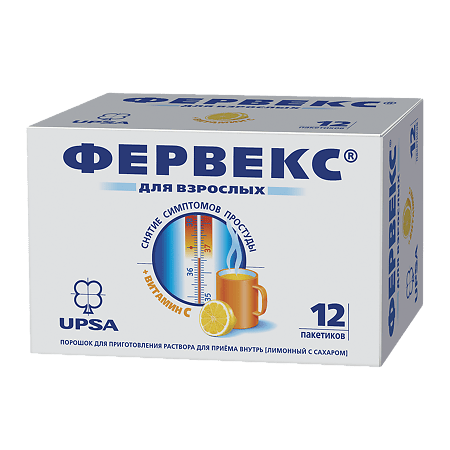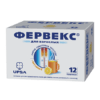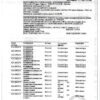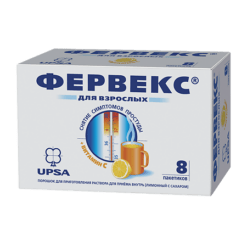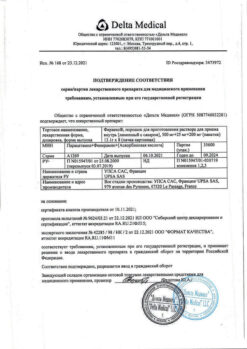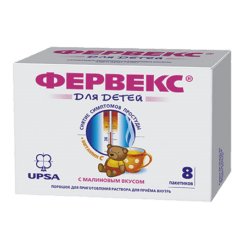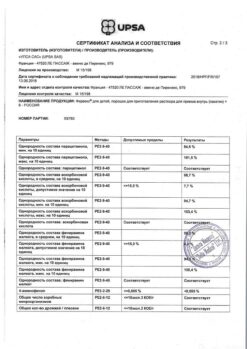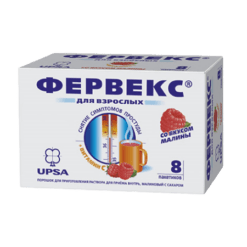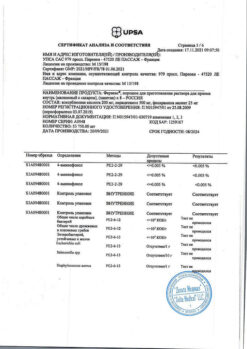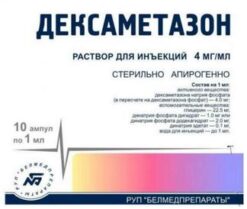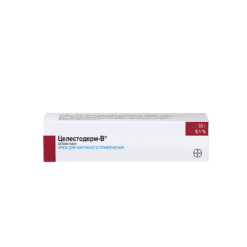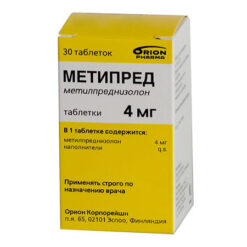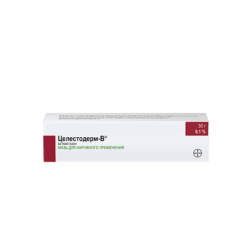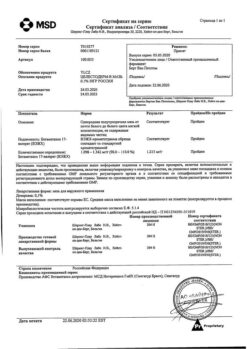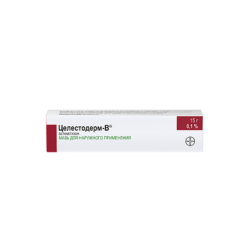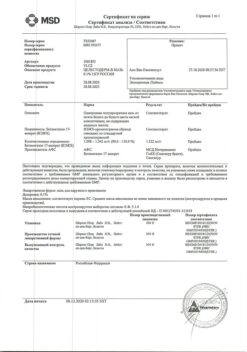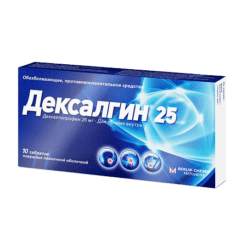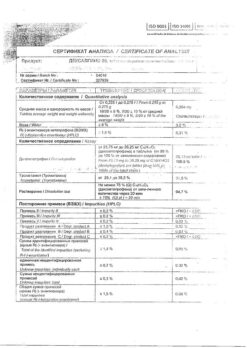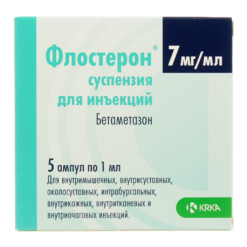No products in the cart.
Fervex, 12 pcs.
€14.24 €12.34
Description
Fervex® is a combined preparation that contains paracetamol, pheniramine and ascorbic acid. Paracetamol is a non-narcotic analgesic, blocks cyclooxygenase, mainly in the central nervous system, affecting the centers of pain and thermoregulation; it has analgesic and antipyretic effects.
Pheniramine is a blocker of H1-histamine receptors, it reduces rhinorrhea and lacrimation, eliminates spasticity, edema and hyperemia of the nasal cavity mucosa, nasopharynx and sinus cavities. Ascorbic acid is involved in the regulation of redox processes, carbohydrate metabolism, blood coagulation, tissue regeneration, the synthesis of steroid hormones, reduces vascular permeability, reduces the need for vitamins B1, B2, A, E, folic acid, pantothenic acid. Improves tolerance of paracetamol and prolongs its action (associated with prolongation of the T1/2.
Pharmacokinetics
Paracetamol:
After oral administration is quickly absorbed from the gastrointestinal tract. Maximum plasma concentrations of the drug are reached 10-60 minutes after ingestion. It is rapidly distributed throughout the body tissues and penetrates through the blood-brain barrier. Binding to plasma proteins is insignificant and has no therapeutic value, but increases with increasing dose.
Metabolism occurs in the liver, 80% of the taken dose reacts with glucuronic acid and sulfates to form inactive metabolites; 17% undergoes hydroxylation to form 8 active metabolites, which conjugate with glutathione to form inactive metabolites.
One of the hydroxylated metabolic intermediates is hepatotoxic. This metabolite is neutralized by conjugation with glutathione, but it may cumulate and in case of paracetamol overdose (150 mg paracetamol/kg or 10 g of oral paracetamol) cause hepatocyte necrosis. It is excreted by the kidneys as metabolites, mainly as conjugates. Less than 5% of the administered dose is excreted unchanged. The elimination half-life is 1 to 3 hours.
Pheniramine:
It is well absorbed in the digestive tract. The elimination half-life from blood plasma is one to one and a half hours. It is eliminated from the body mainly through the kidneys.
Ascorbic acid:
It is well absorbed in the digestive tract. Time of maximum therapeutic concentration (TCmax) after oral administration – 4 hours. It is metabolized mainly in liver. It is excreted by the kidneys, through the intestine, with sweat, unchanged and as metabolites.
Indications
Indications
Used as symptomatic therapy for acute respiratory viral infections to relieve the following symptoms:
– rhinorrhea, nasal congestion;
– headache;
– increased body temperature;
– lacrimation;
– sneezing.
Pharmacological effect
Pharmacological effect
PHARMACOTHERAPEUTIC GROUP: remedy for eliminating the symptoms of acute respiratory diseases (ARI) and “colds” (analgesic non-narcotic drug + H1-histamine receptor blocker + vitamin)
ATX CODE: N02BE51
PHARMACOLOGICAL PROPERTIES
Pharmacodynamics
Fervex®
– a combination drug that contains paracetamol, pheniramine and ascorbic acid. Paracetamol is a non-narcotic analgesic that blocks cyclooxygenase, mainly in the central nervous system, affecting the centers of pain and thermoregulation; has analgesic and antipyretic effects.
Pheniramine is a blocker of H1-histamine receptors, reduces rhinorrhea and lacrimation, eliminates spastic phenomena, swelling and hyperemia of the mucous membrane of the nasal cavity, nasopharynx and paranasal sinuses.
Ascorbic acid is a cofactor in some hydroxylation and amidation reactions – it transfers electrons to enzymes, providing them with a reducing equivalent. Participates in the reactions of hydroxylation of proline and lysine residues of procollagen with the formation of hydroxyproline and hydroxylysine (post-translational modification of collagen), oxidation of lysine side chains in proteins with the formation of hydroxytrimethyllysine (in the process of carnitine synthesis), oxidation of folic acid to folinic acid, metabolism of drugs in
liver microsomes and hydroxylation of dopamine to form norepinephrine.
Increases the activity of amidating enzymes involved in the synthesis of oxytocin, adrenocorticotropic hormone and cholecystokinin. Participates in steroidogenesis in the adrenal glands.
Pharmacokinetics
Paracetamol:
Absorption is high. The time required to achieve maximum concentration (TCmax) is 30-60 minutes; maximum concentration (Cmax) – 5-20 µg/ml.
Communication with plasma proteins – 15%. Penetrates the blood-brain barrier (BBB).
Metabolized in the liver in three main ways: conjugation with glucuronides, conjugation with sulfates, oxidation by microsomal liver enzymes. In the latter case, toxic intermediate metabolites are formed, which are subsequently conjugated with glutathione, and then with cysteine and mercapturic acid. The main cytochrome P450 isoenzymes for this metabolic pathway are the CYP2E1 isoenzyme (mainly), CYP1A2 and CYP3A4 (minor role). With glutathione deficiency, these metabolites can cause damage and necrosis of hepatocytes.
Additional metabolic pathways include hydroxylation to 3-hydroxyparacetamol and methoxylation to 3-methoxyparacetamol, which are subsequently conjugated to glucuronides or sulfates.
Conjugated metabolites of paracetamol (glucuronides, sulfates and conjugates with glutathione) have low pharmacological (including toxic) activity.
The half-life (T1/2) is 1-4 hours. It is excreted by the kidneys in the form of metabolites, mainly conjugates, only 3% unchanged. In elderly patients, drug clearance decreases and T1/2 increases.
Pheniramine: Well absorbed from the digestive tract. The half-life from blood plasma ranges from one to one and a half hours.
Excreted from the body primarily through the kidneys.
Ascorbic acid:
Well absorbed in the digestive tract. The time to create the maximum therapeutic concentration (TCmax) after oral administration is 4 hours. Metabolized primarily in the liver. Excreted by the kidneys, through the intestines, with sweat, unchanged and in the form of metabolites.
Communication with plasma proteins – 25%. Easily penetrates into leukocytes, platelets, and then into all tissues; the highest concentration is achieved in the glandular organs, leukocytes, liver and lens of the eye; penetrates the placenta. The concentration of ascorbic acid in leukocytes and platelets is higher than in erythrocytes and plasma. In deficiency states, leukocyte concentrations decline later and more slowly and are considered a better measure of deficiency than plasma concentrations.
Metabolized primarily in the liver into deoxyascorbic acid and further into oxaloacetic acid and ascorbate-2-sulfate.
It is excreted by the kidneys, through the intestines, with sweat, breast milk unchanged and in the form of metabolites. Excreted during hemodialysis.
Special instructions
Special instructions
The drug does not contain sugar and can be used by patients with diabetes mellitus
diabetes.
Fervex® should not be used simultaneously with other medicines containing paracetamol. To avoid toxic liver damage, paracetamol should not be combined with alcoholic beverages, or taken by persons prone to chronic alcohol consumption.
The risk of developing liver damage increases in patients with alcoholic hepatosis. It should not be used simultaneously with drugs that have hypnotic and anxiolytic effects, and in case of impaired renal function, without consulting a doctor. With long-term use, it is necessary to monitor the picture of peripheral blood, glucose levels in the blood and urine, bilirubin, uric acid in plasma, the activity of “liver” transaminases and lactate dehydrogenase).
If the recommended doses are exceeded and with prolonged use, mental dependence on the drug may appear.
To avoid an overdose of paracetamol, you should ensure that the total daily dose of paracetamol contained in all medications taken by the patient does not exceed 4 g.
The drug contains mannitol and aspartame (a source of phenylalanine); The flavoring contains dextrose.
INFLUENCE ON THE ABILITY TO DRIVE VEHICLES AND MECHANISMS
Considering the possibility of developing undesirable effects such as drowsiness and dizziness, it is recommended to refrain from driving a car or using machinery during treatment with the drug.
Active ingredient
Active ingredient
Paracetamol, Pheniramine, [Ascorbic Acid]
Composition
*- Lemon-rum flavoring: maltodextrin, acacia gum, α-pinene, βpinene, limonene, γ-terpinene, linalool, neral, α-terpineol, geranial, dextrose, silicon dioxide, butylated hydroxyanisole. [raspberry with sugar] – sucrose 11.555 g, citric acid 0.200 g, acacia gum 0.100 g, sodium saccharinate dihydrate 0.020 g, raspberry flavor 0.150 g**
** Raspberry flavoring – ethyl acetate, isoamyl acetate, acetic acid, benzyl alcohol, triacetin, vanillin, p-hydroxy-benzylacetone, maltodextrin, E1450 modified corn starch, E 129 charming red dye, E 133 brilliant blue dye, E 110 sunset yellow dye, permastabil 505528 RI, raspberry 054428 A, sodium chloride and/or sodium sulfate.
Composition
Each sachet contains:
Active ingredients:
Paracetamol – 0.500 g
Ascorbic acid 0.200 g
Pheniramine maleate 0.025 g
Excipients:
[lemon with sugar] – sucrose 11.555 g; citric acid 0.200 g, acacia gum 0.100 g, sodium saccharinate dihydrate 0.020 g, lemon-rum flavoring* 0.500 g*- Lemon-rum flavoring: maltodextrin, acacia gum, α-pinene, βpinene, limonene, γ-terpinene, linalool, neral, α-terpineol, geranial, dextrose, silicon dioxide, butylated hydroxyanisole. [raspberry with sugar] – sucrose 11.555 g, citric acid 0.200 g, acacia gum 0.100 g, sodium saccharinate dihydrate 0.020 g, raspberry flavor 0.150 g**
** Raspberry flavoring – ethyl acetate, isoamyl acetate, acetic acid, benzyl alcohol, triacetin, vanillin, p-hydroxy-benzylacetone, maltodextrin, E1450 modified corn starch, E 129 charming red dye, E 133 brilliant blue dye, E 110 sunset yellow dye, permastabil 505528 RI, raspberry 054428 A, sodium chloride and/or sodium sulfate.
Pregnancy
Pregnancy
There have been no adequate and well-controlled studies of Fervex® in pregnant women, therefore the use of the drug in this group of patients is not recommended.
It is not known whether the active substances of the drug pass into breast milk. The drug should not be used during lactation.
Contraindications
Contraindications
• Hypersensitivity to paracetamol, ascorbic acid, pheniramine or any other component of the drug;
• Erosive and ulcerative lesions of the gastrointestinal tract (in the acute phase);
• Liver failure;
• Angle-closure glaucoma;
• Urinary retention associated with prostate diseases and urinary disorders;
• Portal hypertension;
• Alcoholism;
• Phenylketonuria;
• Glucose-galactose malabsorption, sucrase/isomaltase deficiency, fructose intolerance;
• Children’s age (up to 15 years);
• Pregnancy and lactation (safety has not been studied)
WITH CAUTION
Renal failure, congenital hyperbilirubinemia (Gilbert, Dubin-Johnson and Rotor syndromes), viral hepatitis, alcoholic hepatitis, old age, diabetes mellitus.
Side Effects
Side Effects
The drug is well tolerated in recommended doses. When using the drug, the following side effects were observed (frequency not established):
Disorders of the blood and lymphatic system: anemia, leukopenia, agranulocytosis, thrombocytopenia;
Immune system disorders: allergic reactions (erythema, skin rash, itching, angioedema, anaphylactic shock);
Nervous system disorders: drowsiness, confusion, hallucinations, impaired concentration (more often in elderly patients), agitation, nervousness, insomnia, coordination dysfunction, tremor;
Violations of the organ of vision: disturbance of accommodation;
Cardiac disorders: palpitations;
Vascular disorders: orthostatic hypotension, dizziness;
Gastrointestinal disorders: dry mouth, nausea, vomiting, abdominal pain, constipation;
Renal and urinary tract disorders: urinary problems.
If any adverse reactions occur, stop taking the drug and consult a doctor.
Interaction
Interaction
Ethanol enhances the sedative effect of antihistamines (pheniramine), so its use should be avoided during treatment with Fervex®. In addition, ethanol, when used simultaneously with pheniramine, contributes to the development of acute pancreatitis,
Pheniramine in Fervex® enhances the effect of sedatives: morphine derivatives, barbiturates, benzodiazepines and other tranquilizers, neuroleptics (meprobamate, phenothiazine derivatives), antidepressants (amitriptyline, mirtazapine, mianserin), centrally acting antihypertensive drugs, sedatives belonging to the group of H1-blockers, baclofen; this not only increases the sedative effect, but also increases the risk of developing side effects of the drug (urinary retention, dry mouth, constipation).
The possibility of enhancing central atropine-like effects should be taken into account when used in combination with other substances with anticholinergic properties (other antihistamines, imipramine antidepressants, phenothiazine neuroleptics, m-anticholinergic antiparkinsonian drugs, atropine-like antispasmodics, disopyramide).
When using the drug together with inducers of microsomal oxidation: barbiturates, tricyclic antidepressants, anticonvulsants (phenytoin), flumecinol, phenylbutazone, rifampicin and ethanol, the risk of hepatotoxicity increases significantly (due to paracetamol included in the composition).
Glucocorticosteroids, when used simultaneously, increase the risk of developing glaucoma. Concomitant use with salicylates increases the risk of nephrotoxicity. When used simultaneously with chloramphenicol (chloramphenicol), the toxicity of the latter increases.
Paracetamol contained in the drug enhances the effect of indirect anticoagulants and reduces the effectiveness of uricosuric drugs.
Ascorbic acid increases the concentration of benzylpenicillin and tetracyclines in the blood; at a dose of 1 g/day increases the bioavailability of ethinyl estradiol (including that included in oral contraceptives). Improves the absorption of iron preparations in the intestines (converts ferric iron to divalent iron); may increase iron excretion when used concomitantly with deferoxamine. Reduces the effectiveness of heparin and indirect anticoagulants. When used simultaneously with acetylsalicylic acid (ASA), the urinary excretion of ascorbic acid increases and the excretion of ASA decreases. ASA reduces the absorption of ascorbic acid by approximately 30%. Increases the risk of developing crystalluria during treatment with salicylates and short-acting sulfonamides, slows down the excretion of acids by the kidneys, increases the excretion of drugs that have an alkaline reaction (including alkaloids), and reduces the concentration of oral contraceptives in the blood. Increases the overall clearance of ethanol, which in turn reduces the concentration of ascorbic acid in the body. Quinoline drugs, calcium chloride, salicylates, and glucocorticosteroids deplete ascorbic acid reserves when used for a long time. When used simultaneously, ascorbic acid reduces the chronotropic effect of isoprenaline. With long-term use or use in high doses, it may interfere with the interaction of disulfiram and ethanol. In high doses, it increases the excretion of mexiletine by the kidneys. Barbiturates and primidone increase the excretion of ascorbic acid in the urine. Reduces the therapeutic effect of neuroleptics – phenothiazine derivatives, tubular reabsorption of amphetamine and tricyclic antidepressants.
Overdose
Overdose
Symptoms caused by paracetamol.
In case of overdose, intoxication is possible, especially in elderly patients, children, patients with liver diseases (caused by chronic alcoholism), in patients with malnutrition, as well as in patients taking inducers of microsomal liver enzymes, in which fulminant hepatitis, liver failure, cholestatic hepatitis can develop, in the above cases – sometimes with a fatal outcome. The overdose threshold may be lower in these categories of patients. The clinical picture of acute overdose develops within 24 hours after taking paracetamol.
Symptoms: gastrointestinal disorders (nausea, vomiting, loss of appetite, abdominal discomfort and (or) abdominal pain). pallor of the skin. When administered simultaneously to adults of 7.5 g or more or to children of more than 140 mg/kg, cytolysis of hepatocytes occurs with complete irreversible liver necrosis, development of liver failure, metabolic acidosis and encephalopathy, which can lead to coma and death. 12-48 hours after the administration of paracetamol, there is an increase in the activity of microsomal liver enzymes, lactate dehydrogenase, bilirubin concentration and a decrease in prothrombin concentration. Clinical symptoms of liver damage appear 12-48 hours after a drug overdose and reach a maximum on days 4-6.
Treatment:
Immediate hospitalization. Gastric lavage during the first hours of poisoning, taking enterosorbents (activated carbon, hydrolytic lignin). Determination of the quantitative content of paracetamol in blood plasma before starting treatment as early as possible after an overdose. The introduction of SH-group donors and precursors for glutathione synthesis – methionine and acetylcysteine - is most effective in the first 8 hours. The need for additional therapeutic measures (further administration of methionine, intravenous administration of acetylcysteine) is determined depending on the concentration of paracetamol in the blood. as well as the time elapsed since its introduction.
Symptomatic treatment. Laboratory tests of the activity of microsomal liver enzymes should be carried out at the beginning of treatment and then every 24 hours. In most cases, the activity of microsomal liver enzymes normalizes within 1-2 weeks. In very severe cases, a liver transplant may be required.
Symptoms caused by pheniramine.
Signs of pheniramine poisoning include convulsions, disturbances of consciousness, and coma. If symptoms of poisoning appear, you should immediately stop using the drug and consult a doctor. It is recommended to lavage the stomach, take enterosorbents (activated carbon, hydrolytic lignin), intravenous or oral administration of the antidote acetylcysteine (if possible, in the first 10 hours after an overdose), and symptomatic treatment.
Storage conditions
Storage conditions
At temperatures from 15 to 25°C.
Keep out of the reach of children!
Shelf life
Shelf life
3 years.
Do not use the drug after the expiration date indicated on the package.
Manufacturer
Manufacturer
UPSA SAS, France
Additional information
| Shelf life | 3 years. Do not use the drug after the expiration date stated on the package. |
|---|---|
| Conditions of storage | At 15 to 25 ° C. Keep out of reach of children! |
| Manufacturer | UTSA SAS, France |
| Medication form | Powder for preparation of solution for oral administration |
| Brand | UTSA SAS |
Other forms…
Related products
Buy Fervex, 12 pcs. with delivery to USA, UK, Europe and over 120 other countries.

